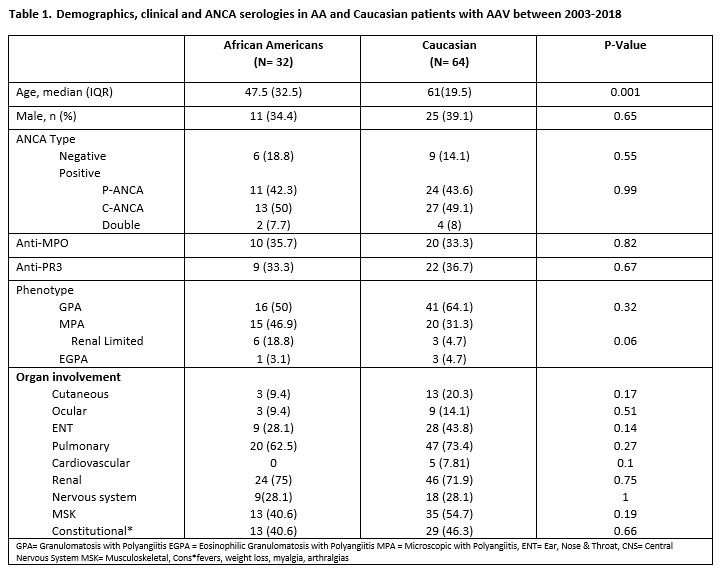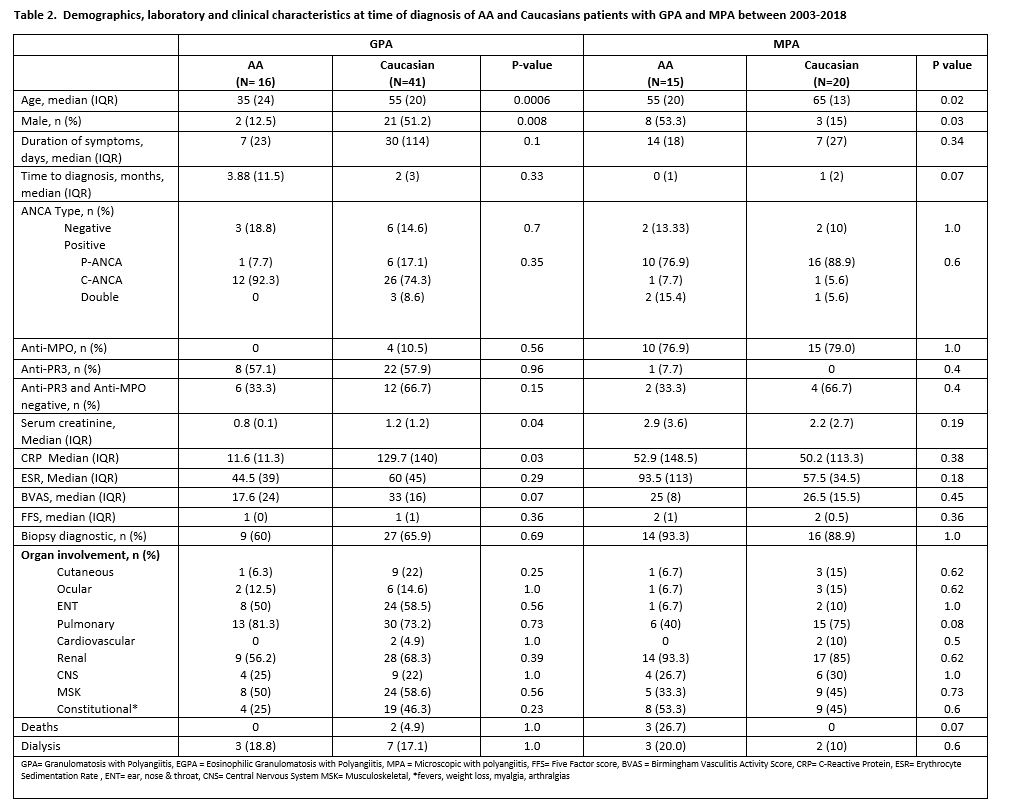Session Information
Session Type: Poster Session C
Session Time: 9:00AM-11:00AM
Background/Purpose: ANCA-associated vasculitis (AAV), including Granulomatosis with Polyangiitis (GPA), Eosinophilic Granulomatosis with Polyangiitis (EGPA) and Microscopic Polyangiitis (MPA), affect mostly Caucasians of European descent. Clinical presentation, clinical features, and prognosis of AAV in African Americans (AAs) have not been well described. The objective of this study was to compare the clinical features and outcomes at time of diagnosis of AA patients with AAV to Caucasian patients. Our hypothesis was that AA patients with AAV present with a higher frequency of MPA, greater disease severity, and experience higher mortality compared to Caucasian patients.
Methods: We conducted a retrospective chart review of patients with ICD-9-CM and ICD-10 codes used for AAV (446.0, 446.4, 447.6 and M31.3, 31.7, M30.1, I77.6, M31.9, M31.8) between 1/2003 to 12/2018. Diagnosis was confirmed by two reviewers (one rheumatologist), and in case of discordance, a third reviewer was involved (rheumatologist). Race was verified through chart review. AA cases were randomly matched by year of diagnosis (± 4 years) in a 1:2 ratio with Caucasian controls. Demographics, clinical and laboratory features, disease activity and prognosis were abstracted by chart review using the Birmingham Vasculitis Activity Score (BVAS) 3 and Five-Factor Score (FFS). T-test, Chi-square and Fisher exact test were used for statistical analysis, when appropriate.
Results: 548 AA patients were identified using diagnostic codes. 56 AA patients were confirmed to have AAV via chart review but only 32 of these cases were confirmed using diagnostic criteria. We matched 64 similarly confirmed Caucasian controls. Compared to Caucasians, AA patients with AAV were younger (47.5 years [IQR 32.5] vs 61.0 years [IQR 19.5], p = 0.001). No other clinical or laboratory features were different compared to Caucasians (Table 1). In addition, we found no difference in frequency of GPA, MPA, or EGPA phenotypes between AA and Caucasians. Younger age at presentation was observed among AAs with GPA (35 [IQR 24] vs 55 [IQR 20), p = 0.006) and MPA (55.5 [IQR 20] vs 65.0 [IQR 13], p = 0.02) (Table 2). Compared with Caucasians, the proportion of women with GPA was higher among AAs (82.3% vs 47.8%, p = 0.008) but the proportion of AA men with MPA was higher (53.3% vs 15%, p = 0.03) (Table 2). There was no difference in disease activity, severity of manifestations or mortality.
Conclusion: In this single center retrospective study, AA patients with AAV presented at a younger age compared with Caucasians. No differences in mortality rates, clinical phenotypes, clinical and laboratory features, disease activity, prognostic scores, or mortality were observed.
To cite this abstract in AMA style:
Palomino L, Gaffo A, Sattui S, Sun D. Clinical Features, Disease Activity and Prognosis of ANCA-Associated Vasculitis in US African Americans [abstract]. Arthritis Rheumatol. 2020; 72 (suppl 10). https://acrabstracts.org/abstract/clinical-features-disease-activity-and-prognosis-of-anca-associated-vasculitis-in-us-african-americans/. Accessed .« Back to ACR Convergence 2020
ACR Meeting Abstracts - https://acrabstracts.org/abstract/clinical-features-disease-activity-and-prognosis-of-anca-associated-vasculitis-in-us-african-americans/


